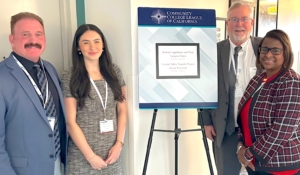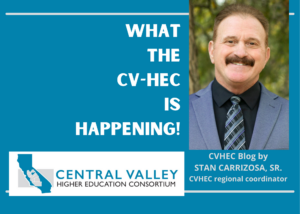To kick off our 2024 “What the CV-HEC is Happening” Blogs, CVHEC Regional Coordinator Stan Carrizosa, Sr. follows up the year-in-review published in our December newsletter issue by offering a perspective of the consortium’s progress in 2023 that sets the stage for a productive new year. Carrizosa, who is president-emeritus of CVHEC member College of the Sequoias and an integral part of the CVHEC team, serves as the lead for the consortium’s Central Valley Transfer Project. The CVHEC blog features perspectives about the higher education community and issues. Submissions are welcome for consideration: Tom Uribes, cvheccommunications@mail.fresnostate.edu.
Propelling successfully, purposefully like a guided rocket
BY STAN A. CARRIZOSA, SR.
CVHEC Regional Coordinator
(President-emeritus, College of the Sequoias)
As a child, I remember watching a weekly science show called “The Undersea World of Jacques Cousteau” that explored the ocean and marine biology.
One fascinating episode depicted how an octopus at any moment could be moving wildly with all eight legs and not advance at all. But once the octopus contracted its core by simultaneously snapping all eight legs in the same direction, a burst of air coming from the fish propelled it successfully and purposefully through the water like a guided rocket.

Stan Carrizosa, Sr. (left) and CVHEC Central Valley Transfer Project team partner Tom Burke presented at the Community Colleges League of California in November along with UC Merced grad student Araceli Tilley who discussed her success with the project’s Program Pathway Mapper software and Jennifer Johnson of the Foundation for California Community Colleges (right).
Over the course of the past 12 months, CVHEC has flexed its octopus legs and undertaken otherwise separate projects like Math Bridge and Master’s Upskilling (dual enrollment) and the Central Valley Transfer Project. By aligning them and their sub-parts, CVHEC has achieved the snapping of its octopus legs successfully surging us forward in the form of real achievement results for higher education in the Central Valley and for our region’s students specifically.
As we move into 2024, the work of CVHEC continues to be more aligned in ways that leverage each element and make the wholistic effort more cohesive and successful. This reminds me how effective it was to do this same thing as a college president. It was important to have clear goals and objectives and planned actions designed to address specific aspects of an issue to ensure greater success.
This past year, CVHEC acted like an organization with big-picture goals for improving student achievement region-wide and a measured plan of actions all designed to work together as a system to achieve success.
The two key drivers of this system for CVHEC success are strong intersegmental partnership commitments to:
- a robust dual enrollment;
- increasing successful community college transfers to higher education institutions.
Biggest DE challenge: qualified instructors
Armed with direct feedback from our first Dual Enrollment Summit held three years ago, we heard that one of the biggest challenges to implementing dual enrollment courses was the ability to find qualified instructors to teach college courses on high school campuses.
CVHEC responded by creating an upskilling project where high school teachers in math and English could earn a master’s degree in their content areas and be qualified to apply for and teach dual enrollment college courses on their high school campuses.
Early results from dual enrollment courses showed that students were more successful when the teacher for their college courses was a member of their regular high school faculty. Under the leadership of Dr. John Spevak, CVHEC regional coordinator and vice-president emeritus of Merced College, who facilitated an impressive package offering high school teachers the opportunity to earn a MA degree in their content areas through our partner universities, this opportunity had many residual benefits such as:
- improving the quality of teaching for their high school classes,
- earning higher salaries at their high school,
- creating a professional learning community between high school and community college teachers,
- and most importantly, changing teacher attitudes about the ability for high school students to succeed in college-level work.
The benefits for high school students are enormous.
Those enrolled in college dual enrollment courses experience pass rates of 80-plus percent while mainstream college students pass rates are in the 50 percent range. Finally, dual enrollment has proven to be a game-changer for first-generation college students in closing the equity gap among them and their college prep peers.
If students are able to take their college math and English courses before graduating high school, they start their college career on a level playing field by having completed their first required courses in transfer-level math and English. This enables them to get on the right pathway and stay straight toward their degree completion.
Incentivizing the efforts to increase transfers
The second key driver for CVHEC in 2023 and moving into the new year is the Central Valley Transfer Project!
The breakthrough moment in this project came when UC Merced agreed to review the CSU ADTs and approve these lower-division sequences as meeting the requirements for successful transfer to UCM. Central Valley CSU’s including Bakersfield and Stanislaus have bought in to the Transfer Project as well. Over the past three years CVHEC has worked to complete implementation in eight of our CV community colleges with three more joining the project this year.
Again the student benefit stands clear: early results show that students in the Transfer Project increase their percentages of on-path course completion each semester by 20 points to 80-plus percent. The same students also reduce their number of units to degree from a high of 85 down to 62.
Meanwhile the new statewide Student Funding Formula starts to provide enhanced per/FTES revenue for successful transfers to four-year institutions, further incentivizing the efforts to increase transfers.
We know that of all the successful graduates earning degrees from CSU’s, 50 percent started their education at a community college. Most recently, California Community Colleges Chancellor Dr. Sonya Christian unveiled her VISION 2030 which includes the Central Valley Transfer Project as a Demonstration Project for the entire state. As a result, CVHEC is now being recruited in both southern and northern California to share the success of the CV Transfer Project with those regions through presentations at various convenings.
Thoughtful and effective continuum creating unprecedented leverage for success
In summary, in addition to tracking and assessing our efforts as individual projects, it is equally if not more important to step back and see the bigger picture in the CVHEC body of work for 2023 that sets the stage for promising 2024. We can see there is a thoughtful and effective continuum that links these efforts together creating unprecedented leverage for success:
- CVHEC started by looking at the data and listening to the practitioners in the field to develop an agenda of work to support our colleges.
- Dual enrollment shows great promise but needs more qualified instructors.
- High school students in dual enrollment courses can close the equity gap between them and their peers thus advancing their personal confidence and capacity to succeed in college.
- Most higher ed students start in our community colleges and now through the Transfer Project they have a clear pathway of courses to take for a successful transfer to four-year universities.
- Once our community college students successfully complete their transfer, statistics show that they represent 50 percent of all university graduates.
So, looking back over the past 12 months, CVHEC – like the octopus snapping our legs to successfully surge forward – has successfully linked together major initiatives to build upon and strengthen each other allowing students to experience a continuum of effectiveness and success in achieving their higher education goals and objectives. To close out 2023 and look ahead, our executive director Dr. Benjamín Durán sums up the CVHEC spirit best in his newsletter director’s message published in our December issue:
“This year we are happy to salute and greet our K-12 partner districts who have joined us in creating meaningful pathways from middle school and high school to college. As we prepare to welcome 2024, stay tuned as we continue to nurture many roads leading to one destination – getting students to and through college in a timely manner!”



